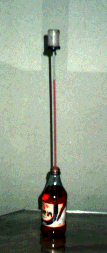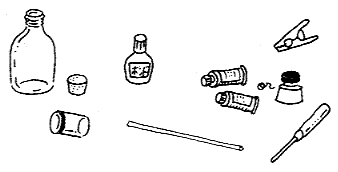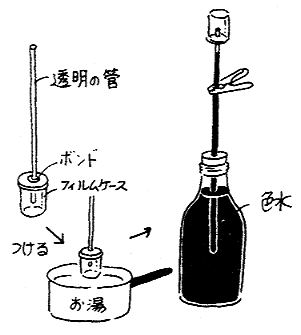
Internet Version [Naruhodo no Mori] Vol. 19
by Yumiko Mori

Vol. 19 Jun 15th, 1996
Galileo Thermometer
Home science experiments for mothers of elementary school children
Tae: "What is this? It looks interesting."
Tae, who just has come home from school, is asking Mom.
Mom: "This is called Galileo's thermometer.
Can you hold this part tightly."

Tae holds the film case.
Mom: "You are holding too strong, Tae!
A little more softly! "
Tae: "Am I holding OK? Oh, look!
The water level is going down."
Mom: "It's down so much. Do you have fever, Tae?"
Tae: "No, I don't feel ill at all."
Mom: "I'm relieved. Do you understand why the water level went down?"
Tae: "I don't know. But still interesting!"
Mom: "You don't know? "
Toshi comes home and finds out the thermometer.
Now he is trying to find what the thermometer does.
Toshi "You are warming air inside and the air volume is increasing.
Did you make this, Mom?"
Mom: "Yes. I learned this at a science meeting yesterday."
Toshi: "Really. This is a simple one."
Mom: "Don't tease me. I can not make anything tricky."
After having snacks, Tae returns to rejoin.
Tae: "Mom, look! This is even lower than before."
Mom: "You are right! It's lower."
Toshi: "I wonder..
maybe we can measure atmospheric pressure with this device.
Then, we will be able to predict weather using this!
Maybe I am a genius?"
Mom: "You can't say that by yourself."
The reason why air volume increases at higher temperature
When temperature increases,
air molecules outside the film case move more rapidly
and therefore bounce harder to the film case surface.
This causes microscopic vibration of the film case
and this vibration causes air molecules inside the case to move more rapidly.
Then the more rapidly moving molecules try to expand in more larger volume.

Materials
- A glass bottle with a transparent color
- A cork cap
(It's not necessary to make tight seal to the bottle.)
- A film case with a transparent color
- An acrylic tube 30cm ~ 50cm
(Transparent color, I used a long curved straw
that I had bought at a dollar store.)
- A glue
(If you want to do quickly, you may use a super glue.)
- Red ink or red color for water painting
(These are used for coloring the water.)
- A screw driver or some other tools
(This is used for making a hole on a film case.)
- Clips
How to make a galileo thermometer
It takes only a half hour if you use a super glue.
In case of a regular glue, it takes over 2 hours.

- Make a small hole at the very center on the lid of the film case.
(The hole has to accommodate the acrylic tube.)
- Insert the acrylic tube into the hole by 1 cm deep.
With glue seal the gap between the tube and the hole.
(Hot glue needs to be melted by heating.
When cooled, the glue becomes solidified.)
- Pour water into the glass bottle and
then color the water by dropping a small volume of the ink
or the water color into the water.
- On the cork cap,
make a hole large enough for the tube to be inserted easily.
Note: You need a small gap (air path) between the cork and the tube,
when the tube is inserted.
Put this cork cap on the bottle.
- Dip the film case for 5 sec.
into water that is close to boiling.
- Put this film case upside down
and quickly insert it into the hole of the cork.
Immediately color water climbs up in the tube.
If the color water stops near the tube top,
your experiment is successful.
* You should avoid to heat up the film case too much.
If you heat up too much, the color water could be coming up into the case.
In that happens, one solution would be to make a hole on the film case.
Excess water should come out from the hole,
and you should reseal the hole with a glue.
The other solution is to expel water by warming up the case or by shaking.
* We used clips for markers.
With markers you'll see the water level fluctuates up and down.
We noticed the water level goes down when the temperature goes up.
So the level does not seem to depend on the atmospheric pressure alone.
* Galileo made a round glass flask for his own experiment.
* One of Galileo's friend,
Santorio Santrorio invented a clinical thermometer
for the first time by modifying Galileo's thermometer.
Find out what your children don't know
I am a little shocked to find out my daughter
didn't know a fact that warmed air has an increased volume.
Perhaps adults learn this fact by experiencing.
I tend to believe anybody know science knowledge as much as I do.
I did not expect my daughter had no knowledge about it.
I wonder how we find out what our children don't know.
I think constant communication with our children helps.
What is your opinion?
| Author | Yumiko Mori (Zushi, Kanagawa, Japan) |
|---|
| Illustration | Mitsue Ogata |
|---|
| Translator | Akira Ishihara |
|---|
| HTML format | Muneo Kume |
|---|
Copyright © 1996 Rika no Heya & Yumiko Mori









